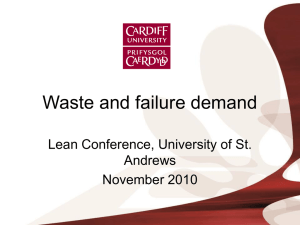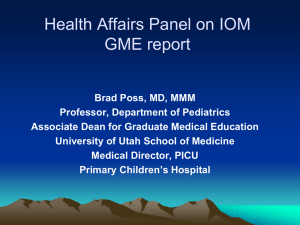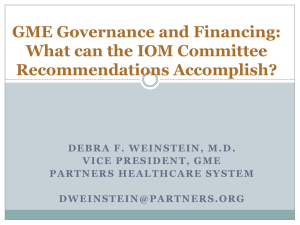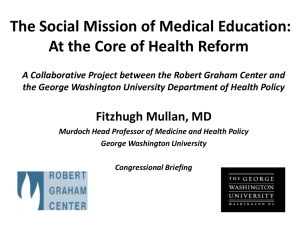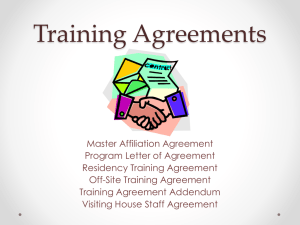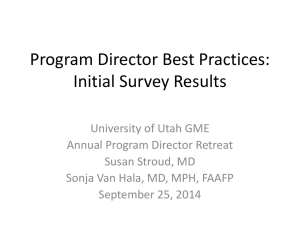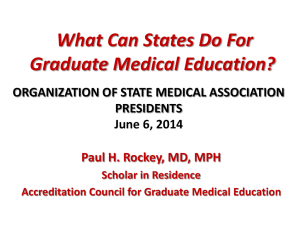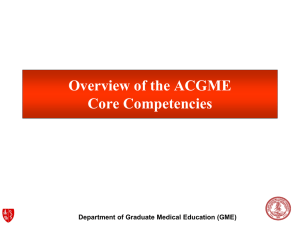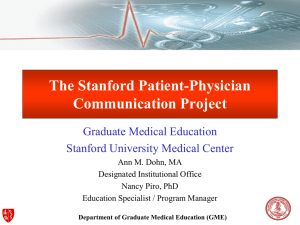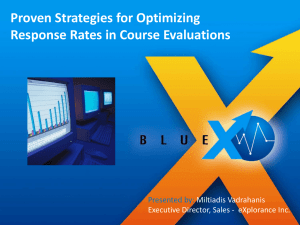Site Visit 102: DIO`s Role for Program Site Visits
advertisement
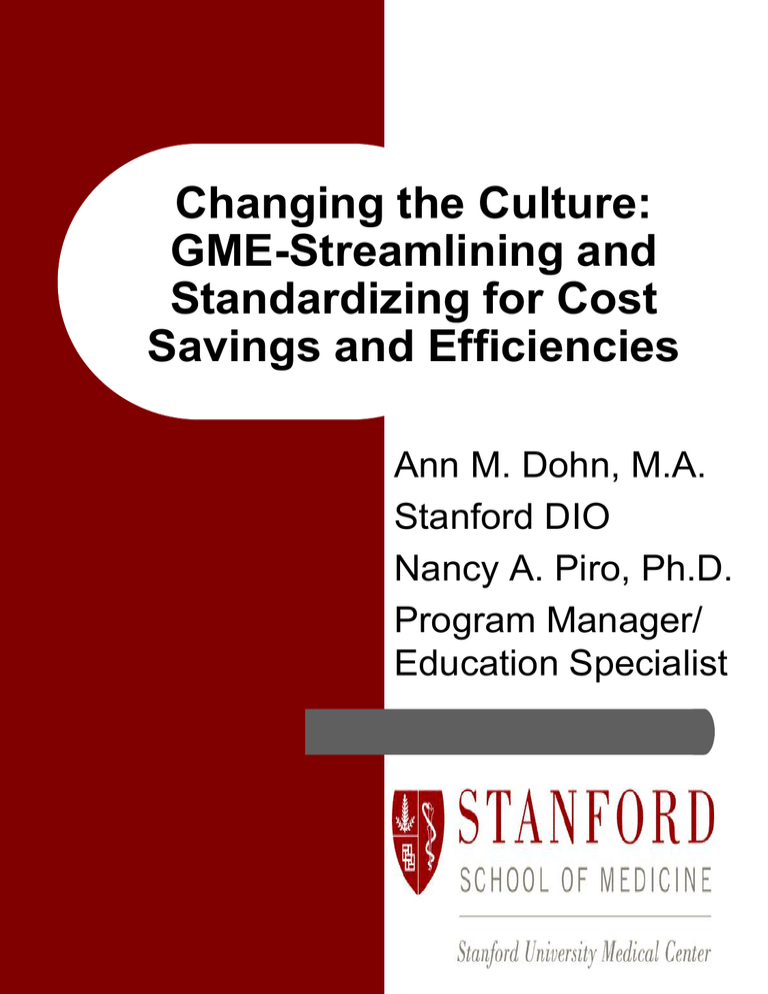
Changing the Culture: GME-Streamlining and Standardizing for Cost Savings and Efficiencies Ann M. Dohn, M.A. Stanford DIO Nancy A. Piro, Ph.D. Program Manager/ Education Specialist Disclaimer No Conflicts of Interest to Report Session Core Competency Focus This presentation addresses the GME Leader Core Competencies of: – – Developing and Supporting Residency Program Directors & Coordinators Managing the Institution’s GME Operations. Three Key Session Objectives 1. 2. 3. Provide a foundation for the understanding and application of lean philosophies and practices to GME. Describe specific process improvement measures that can result in increased efficiency and cost savings in a graduate medical education (GME) setting. Provide a Toolkit Forms Templates Examples to streamline and standardize GME processes at their respective institutions. Thinking Out of the Box? Thinking Outside the Box – Looking to Industry and Corporations What does industry have that we can use? – Conveyor belt to move patients in and out of OR’s? No…. But they do use a “Lean Philosophy” – – Respect for People Total Elimination of Waste And they use “Lean Tools” such as – – – Kaizen 5S’s 3 M’s Lean – Toyota Production System (TPS) TPS system managed to get by with “half of everything”! – – – – Physical space Personnel Capital Investment Inventory Resulted in far fewer than half the defects and safety incidents NUMMI Lean Culture Shift Make problems visible – not hide them or “not talk about mistakes/problems” Fix problems permanently – get to the “root cause” and eliminate it. Focus on the value and respect for people. Lean Tools --- A Sample Kaizen Elimination of WASTE - 3Ms Problem Solving – – – 5 Whys Fishbone Diagrams (Ishikawa Charts) 4 Ms 4 Ps Lean Tools: Kaizen What is ‘Kaizen’? Gradual, unending continuous improvement of processes Processes must be improved to get improved results By improving and standardizing activities and processes, Kaizen aims to eliminate waste Kaizen Basics Focus is on small, incremental change (not necessarily huge leaps, innovation) Quality Control = quality of people – “A company that is able to build quality into its people is halfway to building quality outcomes” Respect for People – “Only people produce improvements” Lean Tools: 3M’s All about Waste- Identifying it and Removing it – – – MUDA = Waste of using resources without creating added value MURI = Waste of overburdening people or equipment/resources MURA = Waste of unevenness, variability in processes Five Why’s Problem Solving Method Keep asking ‘Why’ until you discover the root cause of the problem – No magic in 5 – might be 3, or 7, or 10 Why do we? (conduct orientation in person, fill out multiple forms, take on line training for non MDs) Lean Tools: – Fishbone Charts using the 4Ms – 4 Ps Manpower/Personnel Materials Method(s) Machines / Equipment People Process Policy Principles Ishikawa Diagram of ER Prolonged Wait Times Materials Methods/Process WHY? WHY? WHY? Manpower/People WHY? Machine\Equipment xxx hr wait time in ER 5Ss - Mnemonics Retained Sorting Simplifying Sweeping Standardizing Self Discipline = Seiri = Seiton = Seiso = Seiketsu = Shitsuke QUICK EXERCISE 5Ss in Action 19 BEFORE ER Rooms AFTER Now ---How Can this be Applied to GME? Have read the books Know the materials Understand the tools Have stolen former Toyota Manager … – So what do we do Putting Philosophy into Practice Flowchart the processes – Ask- “Why are we doing this?” Fishbone the problem Huddle to discuss with the team Look for the 3Ms Apply the 5Ss Start with the Current State CURRENT CULTURE – Paper driven registration (forms, forms, and more forms) CURRENT CULTURE – 87 programs (87 fiefdoms all doing their own thing….but having common requirements) Current Culture Lack of standardization/inconsistencies (MURA) Overburden (MURI) Waste (MUDA) of both materials and time – – Lots of files Time to file personnel folders or ACGME letters Time-consuming institutional oversight of programs (MUDA, MURI) Streamlining a GME Process Example What GME Processes would be the best targets to streamline and improve eliminating waste and redundancies? Where to start? Low hanging fruit vs. most impact on residents/faculty/GME staff Actually you can do both!!! Drivers: Where to start? Areas of largest number of ACGME citations? Questionnaire data? – – – – Program Directors’ Needs Analysis Incoming House Staff survey data Annual GME resident survey data Program Coordinator requests Where to start? Huddle-need team involvement – – Respect for people Respect can lead to elimination of unnecessary work Real Time Examples of What We Standardizing We Have Done Project One: Program evaluation standardization Project Two: Orientation standardization/streamlining Project Three: Policy standardization Project Four: Summative evaluation standardization Project Five: Paperless Office/Registration Project One: Standardize Program Evaluations Factors driving decision to standardize: – – – – Largest number of program citations from ACGME Lack of consistent data on program evaluation for APRs (MURA) Huge amount of paper generated to produce suboptimal evaluations (MUDA) Burden of work on the coordinators (MURI) Standardized Program Evaluations What did we do? Developed standardized comprehensive core competency-based Program Evaluations – by Faculty and Trainees Presented the draft templates to the Program Directors who edited and approved them. Standardized Program Evaluations – Process Implementation Annually the GME office: – – – – Delivers --via our Residency Management System (RMS)--176+ evaluations Aggregates each program’s data after the evals have been completed ‘Prints’ (electronically to pdfs) their aggregate Program evaluation reports Posts the Program Eval Reports (pdfs) on their APR site (in the RMS) Program Evaluation Standardization “Toolkit” Example Standardization of Program Evaluations Benefits – – – – Fewer citations Can be input to our Institutional Report Card Easy oversight by DIO/GMEC Early warning system Results of Project One Less paper wasted (none used) Program evaluations sent out centrally by GME using standard evaluation forms Compliance with program evaluation can be easily monitored by GME Reduction in ACGME citations Less concern about confidentiality from house staff Project Two: Orientation Standardization/Streamlining 360+ incoming residents/fellows attending one day orientation sessions – – Completion of various mandated training Issuance of computer codes, pagers, ID badges, parking permits, etc. How do we cope with residents unable to attend orientation? CURRENT CULTURE – Face to face orientation great to know what we look like but big differential in quality of some presentations inability to really control content of each presentation and test knowledge of materials Project Two: Orientation Standardization/Streamlining Wasted both incoming trainee time and staff time - MUDA – 20+ speakers Long lines waiting for such stations as photo ID - MURI Lack of standardization of presentations - MURA Loss of the one auditorium large enough to hold group Difficulty in keeping the attention of the trainees (material overload vs. shopping at Nordstrom's) - MURI Project Two: Web-based Orientation Based on the input from resident orientation questionnaires: – All mandatory modules became Webbased Offered in advance of orientation Many have post tests Can verify completion of training Can be done from home/Starbucks Unintended Outcome Have we gone too far? Project Three: Standardization of Policies Design a policy template for common program requirement policies to reduce redundancies (MURA, MURI, and MUDA) – – – – – – – – Supervision Moonlighting PLAs Recruiting Duty Hours Work Environment Beyond Duty Hours etc. Policy Development Teaching the Use of Policy Templates Program director noon conferences Policy writing workshop Monitoring Implementation of the Policies Verify in our residency management database (system which cannot be named) Easy Online Policy Verification for each program - Example Project Four: Summative Evaluations – The Drivers ACGME Citations – Incoming and Outgoing!! Multiple / variable forms (MURA) Redundant wasted paper (MUDA) Overburden PCs and PDs (MURI) How Do We Do This Efficiently and Effectively? Fill in the blank? Multiple Choice?? Can my coordinator help me out here? Project Four: Summative Evaluations – What did we do? Developed Standard Evaluation Template for Summative Evaluations Comprehensive over program training years Core-competency based User friendly word document Held Program Director and Program Coordinator Teaching Sessions / Workshops Taught the use of the template and how to pair it with aggregated evaluation data from our RMS Use of Resident Evaluations from RMS: Programs could select the evaluations to use – – We recommended: Evaluations Competencies by Resident Resident/Faculty Ranking Report (aggregate) Aggregate Comments Report Evaluation Competencies Report Coordinate with Aggregated Evaluation Data Summative Evaluation Template Macro-enabled Word Doc Additional Considerations Special Cases – At the end of a preliminary year (internship) Need to list Rotations Final Points Review report with trainee Place a copy of the summative evaluation in the Trainee’s permanent file and upload to our residency management system Project Five: The Paperless GME Department Files Program reviews Registration PIF reviews Project Five: The Paperless GME Department Load all forms into the residency management system (RMS) – – – Scan Upload Direct enter Project Five: The Paperless GME Department Program reviews – Review on line Duty hours Policies Annual program review documentation Evaluations – – – – – – % complete Ranking status 360’s Surveys Board pass rates etc… Project Five: The Paperless GME Department PIF Reviews – shared document review on line Project Five: The Paperless GME Department Incoming House Staff – Learning modules web-based – Standardized content Post tests Tracking that all modules complete Annual review of module content Registration Summative Evaluation Acquisition Access to RMS system to enter data Upload forms/documents Project Five: The Paperless GME Department - Results 500 fewer pages of paper per Internal Review x times 2 drafts and an average of 20 Internal Reviews per year = – Savings of 40 reams of paper = Two entire trees saved (17 reams of paper = one tree) Time Saved (walking, waiting, mailing eliminated) Questions? Contact Information: Ann Dohn, DIO – adohn@stanford.edu Nancy Piro, Program Manager – npiro@stanford.edu
